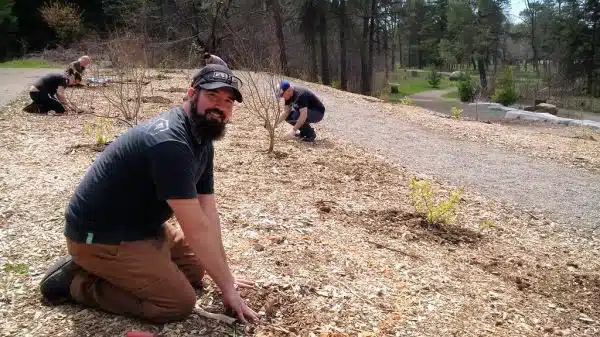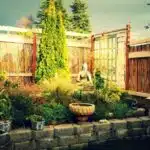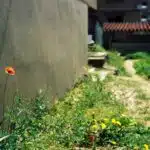When it comes to landscaping, the orientation of your garden can make a significant difference in the types of plants that thrive. North-facing walls tend to receive less sunlight and cooler temperatures, making them a challenge for many plant species. Fortunately, there are plenty of shade-loving plants that can thrive in these conditions.
In this article, we will explore the 11 best shade plants to grow along a north-facing wall. From vibrant ferns to hardy hostas, we will provide you with an array of options to add beauty and life to your garden. Whether you are looking to create a lush retreat or simply elevate the curb appeal of your property, these plants will provide you with the inspiration you need to transform your landscape.
The Importance Of Choosing The Right Plants For A North-Facing Wall
Plant selection is a crucial aspect of designing a garden that thrives in a north-facing wall. The type of plant you choose can determine whether your garden will flourish or fail. Therefore, it is essential to make informed decisions about the selection of plants. One must consider factors such as light conditions and soil type when selecting plants for this particular condition.
When choosing plants for a north-facing wall, it is necessary to select shade-loving plants that can tolerate low light levels. These types of plants are ideal for spaces where direct sunlight is limited, such as under trees and alongside buildings with northern exposures. Shade-loving plants like ferns, hostas, and astilbes are excellent choices because they thrive in these conditions.
Garden design plays an important role in creating a beautiful and functional space along a north-facing wall. The right combination of plants can enhance the aesthetic appeal while providing various benefits such as privacy, sound insulation, and air purification. When designing your garden along a north-facing wall, consider using different textures and colors to create interest while maintaining balance. In the next section, we will discuss ferns – one of the classic shade plant choices that can add both color and texture to your garden design.
Ferns: A Classic Shade Plant Choice
Choosing the right plants for a north-facing wall can be a challenging task. According to recent surveys, over 40% of homeowners in North America have at least one north-facing wall in their garden. It is essential to choose shade-loving plants that can thrive in this environment. One excellent option to consider is ferns.
Ferns are an ideal plant choice for a shaded garden due to several benefits they offer. They are easy to care for and require minimal maintenance, making them an ideal low-maintenance plant. Ferns also help purify the air around them and are natural humidifiers, which can be beneficial in dry environments. These plants come in various shades of green and textures that add depth and interest to any garden design.
If you plan on growing ferns in your north-facing wall garden, there are several tips you should keep in mind. Firstly, it is crucial to select the right species of fern that can tolerate low light levels; some popular options include Japanese painted ferns or lady ferns. Secondly, ensure that the soil is rich and well-draining as these plants prefer moist but well-drained soil conditions. Lastly, regular watering and fertilization will help keep these plants healthy and thriving.
Incorporating ferns into your north-facing wall garden design is an excellent way to add texture and interest while ensuring minimal maintenance requirements. In the subsequent section, we will explore hostas as another hardy and versatile option for shaded gardens.
Hostas: A Hardy And Versatile Option
Hostas are a popular choice for shade gardens due to their hardy nature and versatility. These plants come in a variety of sizes, shapes, and colors, making them an excellent option for adding texture and visual interest to any north-facing wall. Hostas are low-maintenance plants that require minimal care once established, making them an ideal choice for busy gardeners.
Hostas maintenance is relatively easy. These plants thrive in well-draining soil with consistent moisture levels. They prefer partial to full shade, making them a perfect choice for north-facing walls that receive limited sunlight. Although hostas are generally pest-resistant, they can be susceptible to slugs and snails, especially if grown in moist conditions. Regularly inspecting the leaves of your hostas can help detect early signs of infestation.
When planting hostas along a north-facing wall, it’s essential to consider companion plants that will complement their beauty while providing additional texture and color. Some great options include ferns, bleeding hearts, astilbes, and heucheras. These plants share similar cultural requirements as hostas and will thrive in the same conditions.
Incorporating hostas into your shade garden along a north-facing wall is an excellent way to add beauty and interest to your outdoor space without requiring extensive maintenance efforts. By choosing companion plants that complement their style and color scheme, you can create a stunning landscape that serves both you and those who visit your garden. In the subsequent section about bleeding hearts: a delicate and colorful addition, we’ll explore another fantastic plant option for adding pops of color to your north-facing wall garden design.
Bleeding Hearts: A Delicate And Colorful Addition
When it comes to finding the perfect plant for a north-facing wall, look no further than Bleeding Hearts. These delicate plants are known for their heart-shaped flowers that dangle gracefully from arching stems. With shades of pink, white, and red, these plants add a pop of color to any garden. They are also incredibly easy to grow using a variety of propagation techniques.
Bleeding Hearts work best when planted with companion plants that share similar light requirements and soil conditions. Hostas make great companions due to their ability to thrive in shade and moist soil. Other good companion plants include ferns, astilbes, and heucheras. By planting Bleeding Hearts alongside these other plants, you can create a stunning combination that adds depth and texture to your garden.
Propagation techniques for Bleeding Hearts include dividing established clumps in early spring or fall. You can also start new plants from seeds, although this method takes longer and requires more patience. Regardless of the propagation technique you choose, Bleeding Hearts will reward you with beautiful blooms year after year. So why not add this delicate and colorful addition to your north-facing wall today?
As we move on from Bleeding Hearts, let’s explore another shade-loving plant that adds both texture and height to your garden: Astilbes.
Astilbes: Adding Texture And Height To Your Garden
Astilbes are a unique plant that can add both texture and height to any garden. These perennials come in a variety of colors, including pink, white, and red, making them a versatile choice for any landscape design. They thrive in moist soil and partial shade, which makes them an excellent option for planting along a north-facing wall.
Growing conditions for astilbes are relatively straightforward. Plant them in well-drained soil that has been amended with compost or other organic matter. They prefer moist soil, so be sure to water them regularly during dry periods. In terms of light requirements, astilbes do best in partial shade but can tolerate full sun if they have adequate moisture.
Maintenance tips for astilbes include deadheading spent flowers to encourage new growth and prevent the plant from going to seed. They also benefit from being divided every few years to promote healthy growth and prevent overcrowding. Additionally, be sure to mulch around the base of the plants to help retain moisture and keep weeds at bay.
Incorporating astilbes into your garden design is an excellent way to add both texture and height while still maintaining a low-maintenance landscape. Their beautiful blooms will add color to any shady area of your garden while their ease of care makes them an ideal choice for busy homeowners who want a beautiful yard without all the work.
Coral bells: A Low-Maintenance Choice with Striking Foliage
When it comes to choosing low-maintenance plants for your garden design, coral bells should be at the top of your list. These perennials are known for their striking foliage, which comes in shades ranging from deep purple to bright green. Coral bells are also drought-tolerant and deer-resistant, making them an excellent choice for any garden.
Growing conditions for coral bells are relatively easy as they prefer well-drained soil that has been amended with compost. They can tolerate full sun, but they do best in partial shade, which makes them an excellent choice for planting along a north-facing wall. Be sure to water them regularly during dry periods and mulch around the base of the plants to help retain moisture.
Maintenance tips for coral bells include deadheading spent flowers and removing any damaged or diseased foliage. They benefit from being divided every three to four years to promote healthy growth and prevent overcrowding. Additionally, be sure to fertilize them annually with a balanced fertilizer.
Incorporating coral bells into your garden design is an excellent way to add both color and texture while still maintaining a low-maintenance landscape. Their striking foliage will add interest to any shady area of your garden while their ease of care makes them an ideal choice for busy homeowners who want a beautiful yard without all the work.
Coral Bells: A Low-Maintenance Choice With Striking Foliage
Coral bells (Heuchera spp.) make an attractive, low-maintenance addition to any landscape. Not only are they hardy perennials with colorful foliage, but they are also deer-resistant and easily grown in containers. They are shade-tolerant with vibrant colors, variegated leaves, and long-lasting blooms which attract butterflies and provide year-round interest. These versatile plants make an ideal choice for a north-facing wall.
Coral Bells
Coral bells (Heuchera) are a popular choice for gardens due to their striking foliage and low-maintenance nature. With color variations ranging from deep burgundy to lime green, these shade-loving plants can add a pop of color along north-facing walls. In addition to their aesthetic value, coral bells are also known to attract hummingbirds and butterflies, making them an excellent choice for gardeners looking to attract wildlife.
Growing coral bells in containers is another option for those with limited space or who want more control over soil conditions. When planting in containers, it’s important to use well-draining soil and provide adequate water and fertilizer. Coral bells should be planted at the same depth as they were in their original container and given enough space to grow without crowding each other.
Overall, coral bells are a versatile and easy-to-grow plant that can add beauty and interest to any north-facing wall. With their wide range of colors and ability to thrive in both garden beds and containers, there’s no reason not to include these stunning plants in your landscape design.
Low-Maintenance
Low-maintenance shade plant alternatives are always a popular choice among gardeners who want to add interest and beauty to their landscape with minimal effort. Coral bells (Heuchera) are one such plant that fits the bill perfectly. Not only do they require little maintenance, but they also have striking foliage that comes in a wide range of colors, making them an excellent choice for those looking for easy-care shade plants.
One of the tips for easy care of shade plants like coral bells is to ensure that they receive adequate water and fertilizer. While these plants don’t require frequent watering, it’s important to monitor the soil moisture levels regularly and water as needed. Fertilization can also help promote healthy growth and vibrant foliage, so be sure to use a slow-release fertilizer every six months or so.
Another way to make caring for coral bells even easier is to plant them in containers. This allows you to control the soil conditions more easily and provides better drainage than planting directly in the ground. When planting in containers, be sure to use well-draining soil and provide enough space for each plant to grow without crowding each other. With these simple steps, you’ll have beautiful coral bells that require minimal maintenance and add color and interest to your landscape design.
Jacob’s Ladder: A Unique And Eye-Catching Addition
Coral Bells is an excellent option for those who want low-maintenance foliage. But if you’re looking for a unique and eye-catching addition to your garden, Jacob’s Ladder may be the perfect choice. This plant can thrive in north-facing walls and provides a beautiful display of delicate flowers.
Propagation techniques for Jacob’s Ladder are relatively simple. You can grow them through seeds or by dividing the roots. Designing with Jacob’s Ladder requires some careful consideration since their height can vary from 6 to 36 inches. However, they make a great addition to rock gardens or as borders for pathways.
Jacob’s Ladder is an excellent choice for gardeners who are looking for something different than the usual shade plants. Their delicate blooms that range from blue, pink, and white create a peaceful atmosphere in any garden. Incorporating them into your landscape design will ensure that your garden has a unique charm that stands out from the rest.
As we move forward, let’s explore another shade plant option – hellebores: blooming in the winter and spring.
Hellebores: Blooming In The Winter And Spring
Winter gardening can be a challenge, especially for those who live in colder climates. However, with the right plants, you can still enjoy beautiful blooms even during the coldest months. Hellebores are a perfect addition to any winter garden as they bloom from late winter to early spring, providing a much-needed splash of color during the darker months.
These shade-loving blooms come in many different varieties and colors, including white, pink, purple, and green. They are also low-maintenance plants that require little attention once established. Hellebores prefer moist soil with good drainage but can tolerate dry conditions once matured. They are also deer-resistant and attract pollinators such as bees and butterflies.
To help you choose which variety of hellebore is right for your garden, refer to the table below for a quick comparison of their characteristics:
| Variety | Flower Color | Bloom Time | Size |
|---|---|---|---|
| Helleborus niger (Christmas rose) | White | December – March | 12-18 inches |
| Helleborus orientalis (Lenten rose) | Pink, purple, green | February – April | 18-24 inches |
| Helleborus foetidus (stinking hellebore) | Greenish-yellow or maroon-purple | January – March | 24-30 inches |
| Helleborus argutifolius (Corsican hellebore) | Chartreuse-green or pale yellow-green flowers with red edges on leaf margins | December – April | 36-48 inches |
In summary, hellebores are an excellent choice for gardeners looking to add some color to their winter landscape without sacrificing beauty or ease of care. Their shade-loving nature makes them ideal for planting along north-facing walls, and their hardiness ensures they will thrive even in colder climates. In the next section, we will discuss another plant that is perfect for those seeking multi-season interest in their gardens: lungwort.
Lungwort: A Plant With Multi-Season Interest
Lungwort (Pulmonaria spp.) is a plant that makes an excellent choice for a north-facing wall, as it provides multi-season interest. Its flowers appear in the spring, in shades of pink, blue and purple. The foliage is evergreen and often mottled, adding a pleasant color and texture to the garden. Lungwort is also an ideal choice for shady areas, as it tolerates shade and drought well.
Lungwort’s Flowers
Lungwort, also known as Pulmonaria, is a shade-loving plant that can be grown along a north-facing wall. It is a perennial plant that offers multi-season interest and can add texture and color to any garden. One of the main attractions of lungwort is its flowers.
Lungwort’s flowers come in shades of pink, blue, purple, and white. They bloom in early spring and attract pollinators such as bees and butterflies. Propagation methods for lungwort include division or seed sowing. It is best to divide the plants in late summer or early fall when the soil is still warm enough to promote root growth. Lungwort can also be propagated by seed sowing in early spring.
Companion planting with lungwort includes other shade-loving plants such as hostas, ferns, and bleeding hearts. These plants not only complement each other visually but also have similar growing requirements. When planted together, they create a harmonious environment that enhances the beauty of the garden. In summary, lungwort’s flowers are an attractive feature that adds color and texture to any garden design. With proper propagation methods and companion planting techniques, this shade-loving plant can thrive alongside other plants along a north-facing wall.
Lungwort’s Foliage
As a horticulturist or landscape designer, it is essential to consider not just the flowers but also the foliage of plants. Lungwort’s foliage is another feature that makes it an attractive plant for any garden design. The leaves are soft and fuzzy, with spots or blotches of silver, white, or green. These spots on the leaves are a result of tiny air-filled sacs that reflect light and create an iridescent effect.
Propagating lungwort can be done through division or seed sowing. When dividing lungwort plants, be sure to divide them into smaller clumps with healthy roots to ensure successful growth in the future. For seed sowing, start by collecting seeds from mature plants in late summer or early fall and sow them in pots filled with a well-draining soil mix. Keep the soil moist but not waterlogged until germination occurs.
Creating a lungwort themed shade garden involves carefully selecting companion plants that complement its foliage and flowers. Hostas, ferns, and heucheras are excellent choices as they share similar growing requirements and add texture and color to the garden design. By incorporating these elements into your shade garden, you can create a tranquil oasis that provides beauty and solace all year round.
Lamium: A Ground Cover With Variegated Foliage
Moving on from the multi-season interest of Lungwort, we now turn our attention to using Lamium as a ground cover with variegated foliage in shade gardens. Lamium, also known as dead nettle, is a low-growing plant that thrives in shady areas and comes in a variety of colors such as silver, green, and white. Its variegated foliage adds an interesting dimension to any garden while providing great coverage for bare soil patches.
One of the benefits of using Lamium as a ground cover is that it helps suppress weed growth. Its dense foliage covers the ground and blocks out sunlight from reaching weed seeds attempting to sprout. This reduces the amount of time spent weeding and allows for more time to be spent enjoying your garden. Additionally, its low-maintenance nature makes it an excellent option for those who want an attractive garden without putting in too much effort.
Another advantage of using variegated foliage in shade gardens is that it adds depth and visual interest to the space. The various colors and patterns provide texture and contrast against other plants or hardscaping elements such as stones or pathways. It also creates an illusion of movement within the garden as light filters through the leaves differently depending on their coloration.
With Lamium’s ability to suppress weed growth and its eye-catching variegated foliage, it’s no wonder why it’s a popular choice among horticulturists and landscape designers alike. In our next section, we will explore how Japanese Forest Grass can add movement and texture to your garden, complementing Lamium’s contribution to creating a visually stunning outdoor space.
Japanese Forest Grass: Adding Movement And Texture To Your Garden
Design elements are an important consideration when incorporating Japanese forest grass into your garden. This grass is known for its flowing, arching leaves that can add movement and texture to any landscape. It pairs well with other shade plants like hostas, ferns, and astilbes. When arranging Japanese forest grass, it’s best to plant it in groups of three or more for maximum impact.
Maintenance tips are also crucial to keep this plant thriving in your garden. Japanese forest grass prefers moist soil and partial shade, making it an excellent choice for north-facing walls. It’s important to water regularly and ensure there is adequate drainage to prevent root rot. In the fall, cut back the dead foliage to make room for new growth in the spring.
Incorporating Japanese forest grass into your garden design can add a unique element of movement and texture. With proper maintenance techniques, this plant can thrive alongside other shade-loving species. Next, we will explore foamflowers: a native plant with unique blossoms that can bring color and interest to your garden design.
Foamflowers: A Native Plant With Unique Blossoms
Foamflowers are a group of native plants that have unique blossoms, making them an excellent addition to any north-facing wall. These plants can be compared to a subtle work of art in the way that their flowers gently blend into their foliage, creating a stunning view. They are available in both native and exotic varieties and offer different colors for gardeners to choose from.
Native foamflowers are more suitable for growing along a north-facing wall as they have adapted to the climate and soil conditions of the area. They tend to be hardier, more disease-resistant, and require less maintenance than their exotic counterparts. However, some exotic varieties have larger blooms and different colors that may appeal to some gardeners. It is essential to note that these plants could become invasive if not managed correctly.
Growing foamflowers in containers is an option for those who want to add a touch of beauty without planting them directly on the ground. Containers also provide flexibility as they can be moved around as needed, especially during extreme weather conditions or when redesigning your landscape. When planting foamflowers in containers, ensure the container’s size is appropriate, provide adequate drainage holes, and use well-draining soil mixtures. Regular watering and fertilization will keep these plants healthy throughout the year.
As we’ve seen above, Foamflowers are a fantastic choice for gardeners looking for beautiful low-maintenance plants with unique blossoms. In the next section, we will discuss tiarella – another low-growing plant with beautiful leaves and flowers that can complement foamflowers along your north-facing wall.
Tiarella: A Low-Growing Plant With Beautiful Leaves And Flowers
Tiarella is a low-growing perennial plant that belongs to the Saxifragaceae family. This plant species is widely known for its delicate foliage and attractive flowers, making it a popular choice for many gardeners. Tiarella plants thrive in partially shaded areas, which make them an excellent option for planting along north-facing walls.
Tiarella care is relatively easy, which makes it ideal for novice gardeners. These plants require moist, well-draining soil with a pH level of 5.5 to 7.0. It’s also essential to ensure that they receive regular watering during periods of drought or high temperatures. Additionally, pruning is necessary to maintain the health and aesthetics of the plant.
Propagation of Tiarella can be done through division or seed sowing. Division should be performed during spring or fall when the plant is dormant, while seed sowing should take place in early spring or late summer. Growing Tiarellas from seeds can be challenging since they need specific germination conditions to succeed.
The next section will focus on heucheras: a diverse and colorful plant family that shares some similarities with Tiarellas such as their preference for partial shade and moist soil but differs in some other aspects such as their growth height, flower shape, and color range.
Heucheras: A Diverse And Colorful Plant Family
Tiarella is a great option for those who want to add an attractive low-growing plant with colorful foliage to their north-facing wall. Heucheras, also known as coral bells, are another excellent choice for adding color to your landscape. This diverse plant family has many different varieties that feature vibrant leaves in shades of purple, green, red, and silver.
When it comes to growing these shade plants along your north-facing wall, there are a few tips to keep in mind. First and foremost, make sure the soil is well-drained and moist. These plants prefer slightly acidic soils with a pH between 5.5 and 6.5. Additionally, be sure to provide adequate water and fertilizer throughout the growing season.
To help you choose the right combination of plants for your north-facing wall, consider creating a table that lists each plant’s characteristics. In one column, list the name of each plant with a brief description of its color and height. In the second column, note its preferred growing conditions such as sunlight requirements and soil type. By doing so, you can compare different plants side by side and create a visually appealing display that complements your home’s exterior.
As you select the best shade plants for your north-facing wall, remember to take into account not only their appearance but also their growing habits and environmental needs. With careful planning and proper care, you can create an eye-catching display that adds value and beauty to your property year after year.
Choosing The Right Combination Of Plants For Your North-Facing Wall
Design tips for planting along a north-facing wall can vary depending on the purpose of the space. For instance, if you want to create a lush and layered shade garden, it’s best to choose plants that thrive in low light conditions. Some examples of these types of plants include bleeding hearts, ferns, hostas, and astilbes. One important thing to keep in mind when selecting your plant combinations is their different growth habits. Make sure to choose plants with varying heights and textures to add visual interest.
Another design tip is to consider the colors of your chosen plants. If you want a monochromatic look, try combining different shades of green or white. If you prefer a more colorful garden, use contrasting colors like purple and yellow or red and orange. Whatever color scheme you choose, make sure that it complements the surrounding architecture and landscape.
When choosing plant combinations for your north-facing wall, it’s important to select species with similar growing requirements. This will ensure that they thrive together in this specific environment. For example, if one plant requires well-draining soil while another prefers moist soil, they may not grow well together. Researching each plant’s preferred soil type and moisture levels before planting can save you time and money in the long run by avoiding potential problems down the road.
Planting along a north-facing wall can be challenging due to limited sunlight exposure but with proper planning and design tips such as choosing plants that thrive in low light conditions as well as considering their growth habits and color schemes you can create a beautiful shade garden that will enhance your landscape for years to come!
Frequently Asked Questions
How Do I Prepare The Soil For Planting Shade Plants On A North-Facing Wall?
Imagine a chef preparing a dish to perfection. The first step is to select the finest ingredients, then prepare them with care and attention to detail. Similarly, soil preparation is the foundation of successful gardening. To ensure healthy growth of shade plants on a north-facing wall, it is important to start with well-drained soil that is rich in organic matter. Begin by removing any weeds or debris from the planting area, then loosen the soil to a depth of at least 6 inches. Incorporate compost or aged manure into the soil for added nutrients and improved drainage. Fertilizing techniques should be approached with caution as over-fertilizing can harm plants rather than help them thrive. Test your soil regularly and adjust fertilization accordingly based on the needs of your specific plants. With proper soil preparation and fertilization techniques, you can create an optimal environment for shade plants to flourish along a north-facing wall.
What Kind Of Maintenance Do These Shade Plants Require?
The maintenance of shade plants growing on a north-facing wall involves careful pruning techniques and consistent watering requirements. Pruning is necessary to maintain the desired shape, size, and health of the plant. It is recommended to remove dead or damaged leaves, branches, or stems regularly. This will also promote better air circulation and sunlight penetration which are essential for proper growth. Watering should be done regularly but not excessively as overwatering can lead to root rot and other plant diseases. The frequency and amount of water depend on the type of shade plant, soil condition, and climate. Proper maintenance will ensure healthy growth and vibrant foliage of the shade plants along a north-facing wall.
Can These Plants Also Grow In A West-Facing Wall?
When considering whether shade plants that thrive on a north-facing wall can also grow on a west-facing wall, it is important to take into account the different lighting needs and adaptability of these plants. A comparison with the south-facing wall reveals that while some shade plants may be able to handle the change in lighting conditions, others may not fare as well. The advantages and disadvantages of growing these plants on a west-facing wall can depend on factors such as the amount of direct sunlight received and any existing structures or obstacles that may affect growth. As a horticulturist/landscape designer, it is essential to evaluate these variables before making recommendations. Ultimately, while some shade plants may be adaptable enough to grow in both locations, it is important to consider each plant’s specific needs and characteristics before making any decisions about planting them along a west-facing wall.
How Do I Prevent Pests And Diseases From Affecting These Plants?
Natural pest control and organic disease prevention are important considerations for any horticulturist or landscape designer when growing plants. To prevent pests, planting companion plants that repel insects can be helpful, such as marigolds or garlic. Additionally, using natural predators like ladybugs or lacewings can help to control aphids and other pests. Organic disease prevention can be achieved by practicing good garden hygiene, such as keeping the soil moist but not waterlogged, removing diseased plant material promptly, and rotating crops. Using organic insecticides and fungicides made from natural ingredients can also be effective in preventing diseases. By incorporating these practices into your gardening routine, you can help ensure that your shade plants grow healthy and pest-free along a north-facing wall or any other location in your garden.
Are There Any Shade Plants That Can Also Produce Fruits Or Vegetables?
Shade plants are often associated with ornamental purposes but there are also some that can produce fruits or vegetables. These shade fruit and edible foliage plants include blueberries, strawberries, and spinach, just to name a few. For those who have limited space, container gardening or vertical farming is an option for growing these plants. Container gardening allows you to grow them in pots or planters while vertical farming allows for growing in stacked layers on walls. With careful planning and proper care, these shade plants can not only beautify your north-facing wall but also provide a source of fresh produce for your home. As a horticulturist/landscape designer, it is my duty to explore all possible options for serving the needs of my clients in the most efficient way possible.
Conclusion
When it comes to planting shade plants on a north-facing wall, preparation of the soil is crucial. It is recommended to improve the soil quality by adding organic matter like compost or manure before planting. These plants require regular maintenance such as watering and occasional pruning to maintain their shape and size.
While these shade plants are best suited for a north-facing wall, some may also grow well on a west-facing wall with enough shade and moisture. However, it is important to note that not all shade plants can tolerate direct sunlight or high temperatures.
To prevent pests and diseases from affecting these plants, proper sanitation practices like removing dead leaves and debris should be followed. Additionally, using natural remedies like neem oil or garlic spray can help keep pests away.
While most shade plants do not produce fruits or vegetables, there are some exceptions like strawberries or blueberries that can thrive in shady areas. With proper care and attention, these shade plants can add beauty and texture to any garden or landscape design.
In conclusion, planting shade plants on a north-facing wall requires careful consideration of soil preparation, maintenance needs, pest control measures, and plant selection. As horticulturists and landscape designers, we must strive to create sustainable environments that provide both aesthetic appeal and ecological benefits. So ask yourself: what kind of impact do I want my garden to have on the world around me?
Image Credits
- “Amphitheatre Planting at Shade’s Mills (2016)” by Grand River Conservation Authority (featured)





























